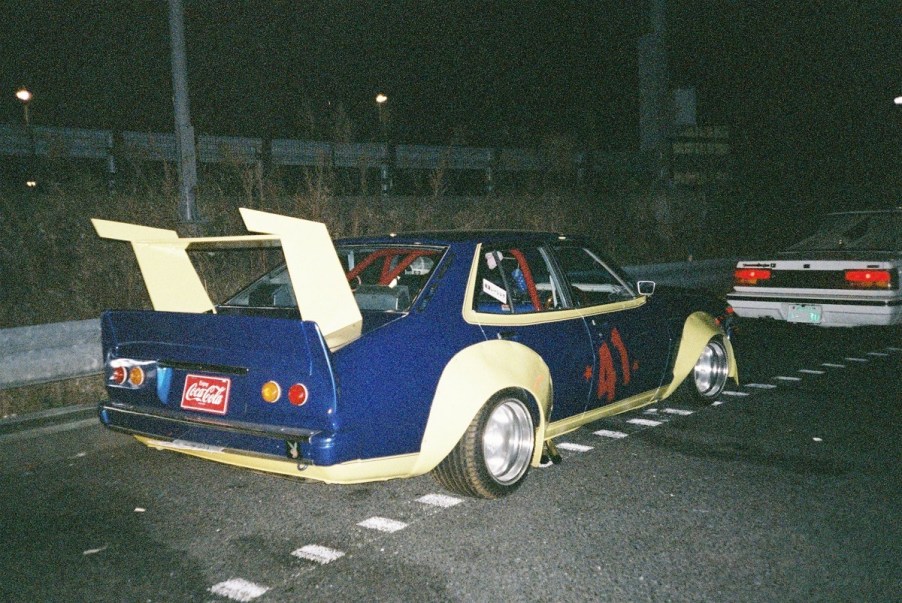
Kaido Racer 101: Everything You Need to Know
For the past few years, wild and crazy-styled Japanese cars have popped up on Youtube thumbnails and Instagram pages. While many refer to these cars as “bosozoku,” there is a proper term for them known as “Kaido Racers.” These cars have wide wheels, racecar paint schemes, and loud exhausts. The confusion in terminology comes from the coverage of these cars. A dedicated group promoting the culture here in the US is working to educate more people about the history of the modifications and culture. Here are the basics about kaido racers and some of their history to save you trouble at the next car meet.
Kaido racer styles

The first style you’ll want to know about is “Grachan.” In 1971, Fuji International Speedway started a new racing series called the Fuji Grand Championship, shortened to “Grachan.” Companies like Nissan and Mazda would battle on track using a “works team.” Either funded by the manufacturer or privately owned, the teams gained popularity along with the racing series. Fans of the race series began to copy the modifications and look of the race cars. In 1975, Holiday Auto Magazine published a reader-submitted photo column of these newly modified cars called “Oh MY! 街道レーサー” (kaido racer) and coined the term. “Kaido” translates to highway, so these highway racers were the “copies” of the racecars people drove on the street.
Building a kaido racer

Next up, a popular style called Haiso gained traction in the 1980s. Japan was in its best economic period during this time, so auto manufacturers focused on building big luxury sedans. Another term coined by Holiday Auto Magazine, Haiso, is a compound word using the English words for “High Society.” Cars like the Nissan Gloria and Toyota Mark II were given chrome fender trim, pearls strung from the mirror, and even things like a chandelier instead of a typical interior light. In addition, wheel fitment was less aggressive than the Grachan cars and more focused on luxury.
The last style is the easiest to understand. Kyusha is a popular styling of kaido cars. When translated, Kyusha is just Japanese for “old car.” Much like American muscle cars, the vehicles used are classics that have undergone restoration or are survivors. The cars receive a “day two” modification, simple bolt-ons like exhaust, wheels, bucket seat, or steering wheel. Focus is put on accenting the original car without really changing the look.
Modifications for a kaido racer

There is a large number of modifications you can make for a kaido racer. The important thing to start with is a good base car. Common base cars in the US are the 1969-1978 Datsun 240z, 1976-1988 Toyota Cressida, and 1978-1985 Mazda RX-7. Plenty of other cars can work, but these are the easiest ones to find that have plenty of inspiration to pull from. One of the most significant modifications for these cars is the wheels. The first step is always to lower the car as much as possible, but the second step is to get a good wheel style. The wheels most commonly used for kaido racers are the SSR MK1, SSR MK2, Devil Japan Shadow Spoke, Hayashi Racing Techno Phantom, SSR Longchamps, and the Hiro V1-R.
Another common modification is the exhaust. Many used pipes with no mufflers at all to mimic the loud exhausts of racecars. Refining the sound even more, people only use 1.5-inch and 2-inch pipes for the exhaust to achieve a specific tone. The last common exterior modification you will see is tail light swaps. Using tail lights from vehicles like the Mazda Titan or Toyota Carina became a big part of the style. KaidoRacer goes into more detail on specific parts and the history behind why they are used.
Should you build a kaido racer?
In short, you should absolutely build a kaido racer. The culture is wild, expressive, and fun. Not only are the cars still available and somewhat obtainable, but the community is also tight-knit in the US and Canada. You can attend a handful of events to meet the people involved in the culture and see some of these cars firsthand.


